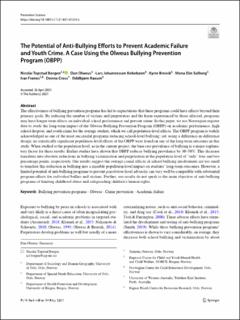| dc.contributor.author | Borgen, Nicolai Topstad | |
| dc.contributor.author | Olweus, Dan | |
| dc.contributor.author | Kirkebøen, Lars Johannessen | |
| dc.contributor.author | Breivik, Kyrre | |
| dc.contributor.author | Solberg, Mona Elin | |
| dc.contributor.author | Frønes, Ivar | |
| dc.contributor.author | Cross, Donna | |
| dc.contributor.author | Raaum, Oddbjørn | |
| dc.date.accessioned | 2022-03-03T09:03:00Z | |
| dc.date.available | 2022-03-03T09:03:00Z | |
| dc.date.created | 2021-07-13T17:20:58Z | |
| dc.date.issued | 2021 | |
| dc.identifier.issn | 1389-4986 | |
| dc.identifier.uri | https://hdl.handle.net/11250/2982714 | |
| dc.description.abstract | The effectiveness of bullying prevention programs has led to expectations that these programs could have effects beyond their primary goals. By reducing the number of victims and perpetrators and the harm experienced by those affected, programs may have longer-term effects on individual school performance and prevent crime. In this paper, we use Norwegian register data to study the long-term impact of the Olweus Bullying Prevention Program (OBPP) on academic performance, high school dropout, and youth crime for the average student, which we call population-level effects. The OBPP program is widely acknowledged as one of the most successful programs reducing school-level bullying; yet, using a difference-in-difference design, no statistically significant population-level effects of the OBPP were found on any of the long-term outcomes in this study. When studied at the population level, as in the current project, the base rate prevalence of bullying is a major explanatory factor for these results. Earlier studies have shown that OBPP reduces bullying prevalence by 30–50%. This decrease translates into absolute reductions in bullying victimization and perpetration at the population level of “only” four and two percentage points, respectively. Our results suggest the average causal effects of school bullying involvement are too small to translate this reduction in bullying into a sizeable population-level impact on students’ long-term outcomes. However, a limited potential of anti-bullying programs to prevent population-level adversity can very well be compatible with substantial program effects for individual bullies and victims. Further, our results do not speak to the main objective of anti-bullying programs of limiting childhood abuse and safeguarding children’s human rights. | en_US |
| dc.language.iso | eng | en_US |
| dc.publisher | Springer | en_US |
| dc.rights | Navngivelse 4.0 Internasjonal | * |
| dc.rights.uri | http://creativecommons.org/licenses/by/4.0/deed.no | * |
| dc.title | The Potential of Anti‑Bullying Efforts to Prevent Academic Failure and Youth Crime. A Case Using the Olweus Bullying Prevention Program (OBPP) | en_US |
| dc.type | Journal article | en_US |
| dc.type | Peer reviewed | en_US |
| dc.description.version | publishedVersion | en_US |
| dc.rights.holder | Copyright The Author(s) 2021 | en_US |
| cristin.ispublished | true | |
| cristin.fulltext | original | |
| cristin.qualitycode | 1 | |
| dc.identifier.doi | 10.1007/s11121-021-01254-3 | |
| dc.identifier.cristin | 1921626 | |
| dc.source.journal | Prevention Science | en_US |
| dc.source.pagenumber | 1147-1158 | en_US |
| dc.identifier.citation | Prevention Science. 2021, 22, 1147-1158. | en_US |
| dc.source.volume | 22 | en_US |

